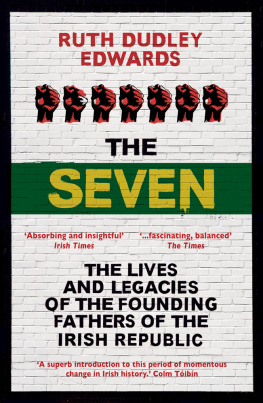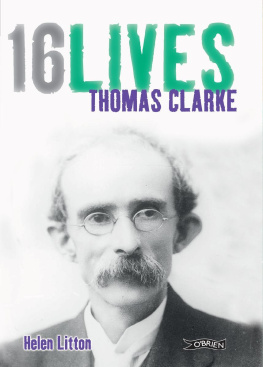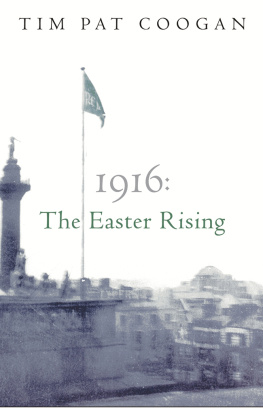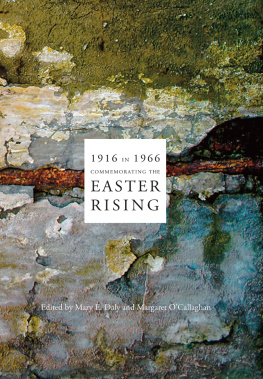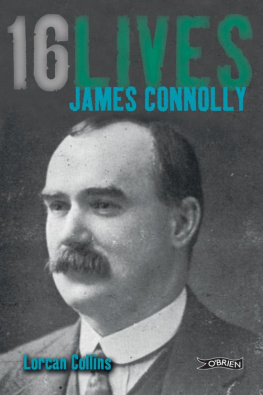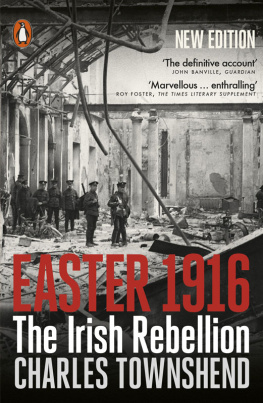TheLIVESSeries
JAMES CONNOLLY Lorcan Collins
MICHAEL MALLIN Brian Hughes
JOSEPH PLUNKETT Honor O Brolchain
EDWARD DALY Helen Litton
SEN HEUSTON John Gibney
ROGER CASEMENT Angus Mitchell
SEN MACDIARMADA Brian Feeney
THOMAS CLARKE Helen Litton
AMONN CEANNT Mary Gallagher
THOMAS MACDONAGH Shane Kenna
WILLIE PEARSE Roisn N Ghairbh
CON COLBERT John OCallaghan
JOHN MACBRIDE Donal Fallon
MICHAEL OHANRAHAN Conor Kostick
THOMAS KENT Meda Ryan
PATRICK PEARSE Run ODonnell
I am very grateful to Honor O Brolchain for introducing me to Michael OBrien, who trusted me to write this biography of my grand-uncle, amonn Ceannt. I am equally grateful to my editor, Ide N Laoghaire, who rescued my initial draft from the byways of historical context and family anecdotes. Lorcan Collins and Run ODonnell, the series editors, together with Emma Byrne, Nicola Reddy and the team at OBrien Press, were always helpful and supportive.
My thanks are also due to the archivists and staff at the National Library of Ireland, National Archives of Ireland, the Bureau of Military History, the Archives Department of University College, Dublin, the Allen Library, the Royal Dublin Society, Dublin City Library and Archive, and South Dublin County Libraries. They were unfailingly helpful and courteous. I am particularly grateful to the librarians in my local library, Ballyroan Library, who acquired many of the books and references I needed. On-line access to original sources made my life immeasurably easier. The ability to search for the unusual name of Ceannt gave me access to a wide range of sources I might otherwise have missed. They include the Census of Ireland 1901 and 1911, the witness statements from the Bureau of Military History, the Irish Court of Petty Sessions Court Registers at findmypast.ie and a wide range of national and local newspapers at Irish Newspaper Archives Online.
When William Henry wrote the first biography of amonn, Supreme Sacrifice: The Story of amonn Ceannt: 18811916, (2005), he approached my late sister, Joan, and myself for assistance. We were delighted to help but came to recognise the limitations of our knowledge. In the past few years I have had the opportunity to rectify that and I hope William will forgive any shortcomings in the information with which we then provided him.
Before attempting to write amonns life story, I had the great pleasure of returning to my alma mater, University College Dublin. My thanks are due to the School of History and Archives, in particular Professor Michael Laffan, Dr Lindsey Earner-Byrne, Professor Diarmaid Ferriter and their colleagues. I am also grateful to my fellow students, particularly Margaret Ayres, Tom Burke, Declan OKeefe and Conor Mulvagh. My thanks are similarly due to Sean Murphy and my fellow students in the certificate course in Genealogy and Family History for a thorough grounding in genealogical research methods.
amonn naturally wrote many of his letters, diaries and articles in his beloved Irish, and I am particularly grateful to Siobhn N Mhathna and my cousin, Tuhye Gillan, for their help in translating them.
My thanks are also due to Dr Joe McPartlin, Trinity Centre, St Jamess Hospital, who organised a seminar, Easter 1916 at the South Dublin Union, in April 2014. Dr Patrick Geoghegan, Trinity College, chaired and the speakers were myself, Prof Davis Coakley and Paul OBrien. Prof Coakley very kindly showed me around the site of the SDU at St Jamess Hospital.
Finally, I want to place on record my deep gratitude to my family living and departed. My late grandfather, Michael Kent, wrote our family story in his diaries from 19111920. His daughter, Joan Kent, preserved them, tenderly wrapped in brown paper and hidden away on top of a wardrobe. She also kept Bill Kents letters to Michael, from the Boer War to Flanders, and many other family photographs and memorabilia. My sister, Nora Sleator, her husband Louis, and my nieces Niamh and Clodagh have supported me patiently throughout the long months of research and writing, as have the extended Ceannt, Gillan and Sheehy families. My equally patient and supportive friends regularly ask, hows amonn getting on? I hope this book will answer their question!
184551. The Great Hunger in Ireland. One million people die and over the next decades millions more emigrate.
1858, March 17. The Irish Republican Brotherhood, or Fenians, are formed with the express intention of overthrowing British rule in Ireland by whatever means necessary.
1867, February and March. Fenian Uprising.
1870, May. Home Rule movement founded by Isaac Butt, who had previously campaigned for amnesty for Fenian prisoners.
187981. The Land War. Violent agrarian agitation against English landlords.
1884, November 1. The Gaelic Athletic Association founded immediately infiltrated by the Irish Republican Brotherhood (IRB).
1893, July 31. Gaelic League founded by Douglas Hyde and Eoin MacNeill. The Gaelic Revival, a period of Irish Nationalism, pride in the language, history, culture and sport.
1900, September.Cumann na nGaedheal (Irish Council) founded by Arthur Griffith.
190507.Cumann na nGaedheal, the Dungannon Clubs and the National Council are amalgamated to form Sinn Fin (We Ourselves).
1909, August. Countess Markievicz and Bulmer Hobson organise nationalist youths into Na Fianna ireann (Warriors of Ireland) a kind of boy scout brigade.
1912, April. Asquith introduces the Third Home Rule Bill to the British Parliament. Passed by the Commons and rejected by the Lords, the Bill would have to become law due to the Parliament Act. Home Rule expected to be introduced for Ireland by autumn 1914.
1913, January. Sir Edward Carson and James Craig set up Ulster Volunteer Force (UVF) with the intention of defending Ulster against Home Rule.
1913. Jim Larkin, founder of the Irish Transport and General Workers Union (ITGWU) calls for a workers strike for better pay and conditions.
1913, August 31. Jim Larkin speaks at a banned rally on Sackville (OConnell) Street; Bloody Sunday.
1913, November 23. James Connolly, Jack White and Jim Larkin establish the Irish Citizen Army (ICA) in order to protect strikers.
1913, November 25. The Irish Volunteers are founded in Dublin to secure the rights and liberties common to all the people of Ireland.
1914, March 20. Resignations of British officers force British government not to use British army to enforce Home Rule, an event known as the Curragh Mutiny.


